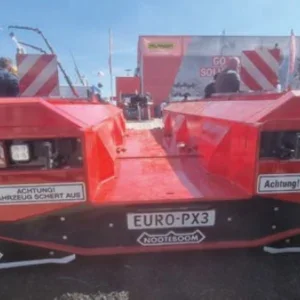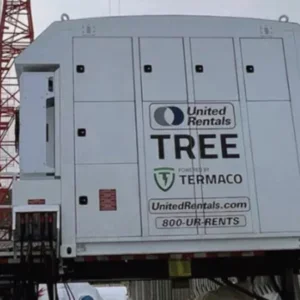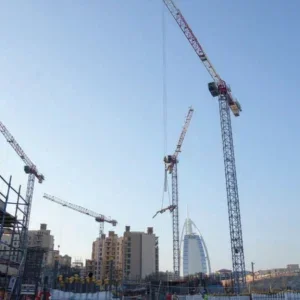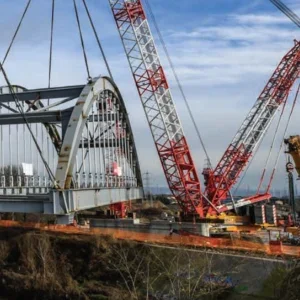While the LTM 1160 was the first crane of this size to be named an ‘all terrain’, it had been preceded by several so-called truck cranes that could have also easily been branded the same way. The key technical elements that came to distinguish the ’all terrain’, had been coming for many years as customers sought better off-road performance as well as more compact and maneuverable larger-sized cranes.
Throughout the 1970s, before it became a major crane maker in its own right, Faun had led crane carrier design and done more than anyone to promote the benefits of hydro- pneumatic suspensions, multiple drive and steer axle configurations and the application of single rather than dual drive tyres.
Düsseldorf’s pioneering Leo Gottwald KG was the first to commit to amalgamating all of these features into very compact mobile cranes with its fiveaxle 125t AMK 155-53 of 1973 and 1980’s six axle 140t AMK 146-63, which featured a pin-locked telescopic boom. In 1982, Mannesman Demag introduced a boom guying system and super lift counterweight on its 160t six axle HC 510.
In 1987, Gottwald sold the rights to its telescopic cranes to Krupp, declaring at the time that the market was driven purely by price and volume. Krupp was subsequently sold to Grove, and then to Manitowoc. The following year, Mannesman Demag bought the lattice boom part of the Gottwald line. After further deals, Demag’s telescopic cranes ended up, in 2003, becoming part of Terex.
Liebherr’s singular commitment to the all terrain concept, however, did more than anyone to drive the industry in this new direction. Over the course of a quarter century of development, the rated capacity of six axle cranes has increased by 2½ times (from 160t to 400t), maximum boom length has increased by 75% (from 45m to 80m) and maximum system length by almost 50% (from 94m to 140.5m), all within the 72t GVW roading package.
The list of qualitative performance, safety and operator-related enhancements is very long, and includes: ‘active’ rear steering systems with speed dependent engagement; ABS disc brakes; remote control for rigging operations, etc.; hydraulically offsetting jibs; programmable controls, lift planning and telematic devices; automatic outrigger levelling; fast-cycling pinned booms; self-erecting ‘Superlift’ load-enhancing devices; stepless jib load chart interpolation; and multiple boom length-related operating configuration options.
For many years, the contest between manufacturers in this class and, for that matter, most others, has been simply aimed at building the highest capacity crane with the longest boom. Today, the choice is more nuanced. In the six-axle category, the customer can now select cranes that fall, roughly, into three general ranges:
• 350t–400t cranes offering boom lengths of 60m–70m and with a broad choice of versatile jibs including long luffing boom or offset jibs.
• 250t–300t cranes offering booms of 70m– 80m length and easily deployed jib systems for typical crane rental applications.
• 150t–200t cranes offering booms of 60- 70m length with a range of easily deployed jib systems and a capability to carry partial counterweight plus jibs within a road-legal package for ‘taxi’ crane work.
A check of our comparison table, illustrates how the leading European manufacturers are addressing these varying market demands with both Liebherr and Terex-Demag now offering three models and Grove recently introducing two new ones.
In contrast, the Chinese cranes in this six-axle class are presently crowded in the 180t–260t class. While perhaps not yet competing on the same features as European cranes, XCMG, Zoomlion and Sany continue to demonstrate their relentless commitment to pushing the limits of their technology and must be taken very seriously.
For a very long time the Japanese market has accommodated cranes of higher like-for-like road weights than allowable in Europe and America. Domestic customers have been able to fulfil their preferences for cranes with higher levels of structural stiffness. For years this has generally resulted in cranes with shorter, simpler boom systems. However, Tadano-Faun’s ‘Global’ AT crane philosophy is clearly aimed at drawing Japanese domestic customers towards the international technology norm. Though introduced in 2007, the marketing of this crane has thus far been restricted to the Japanese market.
As their maximum capacity has increased from a range of 140t–200t in the 1980s to 350t–400t today, six-axle cranes have vacated the larger volume market sectors. Nevertheless, in this author’s estimations, approximately 2,100 six axle all terrains have been sold over the past 25 years, with probably 95% of these still in service. However, due to the pace and level of product development, most of the older cranes now find themselves uncompetitive in the more-demanding and regulated Western markets. Their shorter booms, slower erection times, greater vehicle lengths, more difficult rigging requirements and inability to legally carry working counterweights have meant that many aging cranes have found their way to emerging markets.
Almost 60 different models of six axle AT have been produced over the years with, by our estimations, approximately 50% of these being of 125t–160t capacity; 40% of 180t– 300t capacity and 10%—only five models— of 350t–400t capacity. While Demag pioneered most of the nominal lifting capacity breakthroughs (200t in 1987; 300t, 1998; 350t, 2002), this year’s Bauma saw Grove introduce the first six axle 400-tonner in the shape of the GMK 6400.
It is also significant that only eight cranes have been produced with boom lengths in excess of 65m length. This group now includes the XCMG QAY 240 with its 67m boom. The current maximum remains 80m, held by the 250t Terex-Demag AC 250- 1 and newly announced 300t Grove GMK 6300L. As boom lengths have increased, the need to deploy jibs has receded—much to the delight of crane operators and riggers, not to mention safety experts.
While certainly Demag has played a role in the development of cranes in this class that is every bit as significant as that of Liebherr, it is the pioneering Ehingenbased manufacturer that has retained dominance in the sales of these large cranes. By this author’s estimation, Liebherr has accounted for almost 50% of the entire volume of six axle ATs sold worldwide over the last 25 years, with sales of approximately 1,000 units. By comparison, I estimate that Demag has won approximately 25% of the market, followed by Krupp and Grove combined taking approaching 20% and the other players taking the remainder.
As with any larger-sized mobile crane, road regulations continue to be a primary driver of product innovation. As regulation enforcement measures have tightened, crane designers have responded with lighter and more manoeuvrable machines evolving into the excellent variety of solutions available to customers today. Talking to major crane rental companies on both sides of the Atlantic highlights different operational challenges that, as ever, have local road regulations as a backdrop.
With over 400 Liebherr cranes, Ainscough is the largest owner of Liebherrs in the world and controls approximately 35% of the UK crane hire market. “We believe very strongly in standardisation, whether it’s our cranes, our ballast wagons (MAN) or our trailers (Nooteboom)”, says managing director Neil Partridge. “Certainly it was something of a departure for us to buy the four 350t AC 350/6 Demags [delivered in early 2010]. We found it offered the best value-formoney, has very strong duties and is as compact as older generation 250-tonners.
“Having said that we made a big commitment to the 150t Liebherr when it was nnounced and so far we’ve taken 15 of the 20 units we ordered. We very much like its six-axle configuration—it allows us to road it with about 30t counterweight, which is pretty useful for a lot of work. In many cases it saves us having to send a ballast wagon, which, what with the driver, fuel and time involved, is quite a saving. We’ll be taking the 16th unit later this year and the remaining four next year. Between the 150s and the 350-tonners we’ve got our 200-tonners and I think the largest fleet of 250-tonners in the country with seven units—all Liebherrs. But nobody makes a bad crane today: Demag, Manitowoc, Grove, Tadano, they’re all good cranes. But we feel the Liebherr is just a little better.
“In May we closed out our last fiscal year with turnover down about 15% yearon- year, which we think is quite good compared to the overall industry. So far this year has been flat and we’re projecting it to stay that way through yearend. Still, we’ve continued to update our fleet spending around £30m ($50m) per year. We made a significant move back into big lattice with five Demag crawlers and also picked up a one-year old Liebherr LGD 1550 lattice truck crane for a specific wind farm job. Of course, given the market conditions, we’ve reduced our overall fleet size somewhat, but right now we’re pleased with where we are.”
Robert Weiss, CEO of Cranes Inc., New York, has two LTM 1350-6.1s on order—one just leaving the factory and a second due October. “There’s a particular reason for our decision”, he told me. “A real interesting problem cropped up here in New York. Traditionally, the New York Department of Transport (DOT) had issued annual travel permits for mobile cranes, regardless of weight. However, this spring the DOT started to enforce more stringent permitting requirements. As a result, cranes that used to get annual permits to travel, such as the six-axle Liebherr LTM 1250-6.1, are now excluded from the criteria for annual permits. This has therefore forced us to reexamine the make-up of our fleet.
“New York City will still issue annual permits for cranes of up to four-axles with GVWs of up to 80,000lbs (36,000kgs) and axle loads to 22,000lbs (10,000kgs), although axle loads of 26,500lbs (12,000kgs) have now become widely accepted for mobile cranes. In the past we bought cranes that had as much on-board as possible. But now, to address the mobility issue for our larger mobile cranes we’ve bought boom launchers for our new LTM 1350-6.1s and our LTM 1500. Generally speaking, New York hasn’t been much of a six-axle crane market. We’ve got one LTM 1250-1, which we use mainly as a weekend machine, for tower crane work or with luffer. The majority of work in the city is for four- and five-axle taxi cranes. But with the “new” rules we’re going to road the 400USt (350t) Liebherr LTM 1350-6.1 with boom removed. That gets the GVW down below 120,000lbs (54.4t) on its six axles for which we can get an annual permit.
“I was persuaded on the merits of the LTM 1350-6.1 when I visited the factory and saw how their engineers have made boom removal so easy and how much work they had put into making the machine suitable for use in the United States. The other thing that impressed me was the strength of the main boom load chart when working with the Y-Guy. Believe it or not, it compares pretty well with the long-boom LTM 1500. On top of that the Y-Guy selferects. We’ve ordered the first machine fully-loaded with full 258ft (78m) luffer, Y-Guy and adapter for long jib while the second machine also has Y-Guy but without luffer—although its prep’d to take the jibs.”
But how about the current state of the market? Barry Barnes, director of sales, Europe, Terex Cranes admits, “I had the dubious distinction of being awarded responsibility for sales across Europe in mid-2009, when the severity of the economic mess really hit home. Customers across the continent speak with one voice in emphasising the importance they place in new products, especially in tough times. It allows them to win work against lessefficient older cranes and open up new markets, when everyone is lowering their rates and fighting for every scrap of business. That’s why we continue to invest so heavily in new product development.
“Since shipments of our new AC 350/6 began in the spring it’s enjoyed significant success. Here in the UK we’ve already sold six units with Ainscough acquiring four units and King Lifting adding the new 350 to its existing 250-tonner. Given that the economy is not yet improving and the banks not lending, the fact that we continue to take orders is encouraging. Of course the scale of business cannot compare with that of 2008 but customers continue to buy for a variety of reasons—be it to renew their fleet, move into a larger size class, acquire new technology or indeed make trade-ins to help their cash position. We’re selling cranes across the size range – from 40- tonners up – but it does seem that demand for the larger size classes is somewhat stronger. Whilst the plight of the Southern European markets like Spain, Greece and Italy is well known, demand in other major markets like France and Germany is still jogging along quite well.
“Since its introduction in 2007, the 80m boom of the AC 250-1 has been a real magnet to customers. In the UK our 250- tonner roads legally with 100m on-board— the 80m boom plus 20m hydraulically offsettable side-folded extension—as well as with 15t of counterweight and 16.00 tyres. The new AC 350/6 roads with its 64m boom plus 20m hydraulically-offsettable extension, 15t of counterweight, Superlift and 16.00 tyres. Less well known is that we offer a full six axle version of our 200-tonner— known as the AC 200-1P. It’s an alternative to the normal five-axle configuration and should customers require even lower axle weights, a single tag axle is also available”.
In conclusion, what’s instore for the future? Well in this author’s opinion the arrival of 100m long telescopic booms in this class of crane is now only a matter of time. Meanwhile five-axle cranes will continue to expand into the 250t and 300t sectors and push six axle cranes further up the capacity spectrum that today tops at 350t–400t. Why should it stop now?






